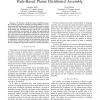Free Online Productivity Tools
i2Speak
i2Symbol
i2OCR
iTex2Img
iWeb2Print
iWeb2Shot
i2Type
iPdf2Split
iPdf2Merge
i2Bopomofo
i2Arabic
i2Style
i2Image
i2PDF
iLatex2Rtf
Sci2ools
IROS
2006
IEEE
2006
IEEE
Combinatorial Optimization of Sensing for Rule-Based Planar Distributed Assembly
Abstract— We describe a model for planar distributed assembly, in which agents move randomly and independently on a twodimensional grid, joining square blocks together to form a desired target structure. The agents have limited capabilities, including local sensing and rule-based reactive control only, and operate without centralized coordination. We define the spatiotemporal constraints necessary for the ordered assembly of a structure and give a procedure for encoding these constraints in a rule set, such that production of the desired structure is guaranteed. Our main contribution is a stochastic optimization algorithm which is able to significantly reduce the number of environmental features that an agent must recognize to build a structure. Experiments show that our optimization algorithm outperforms existing techniques.
IROS 2006 | Optimization Algorithm | Planar Distributed Assembly | Robotics | Rule-based Reactive Control |
| Added | 12 Jun 2010 |
| Updated | 12 Jun 2010 |
| Type | Conference |
| Year | 2006 |
| Where | IROS |
| Authors | Jonathan Kelly, Hong Zhang |
Comments (0)

